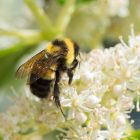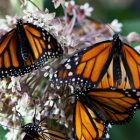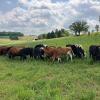They make you laugh, they make you cry – films provide valuable insights and inspiration. As a way of providing outreach on a subject you care about, screening a documentary can be a great entry point for starting a conversation and bringing together like-minded individuals. Consider hosting a screening for your garden club or at your local library or school. Invite guest speakers and host a panel discussion afterward. Holding a public screening needn’t be complicated, but be sure to request permission from the filmmaker before doing so. You’ll need to request public performance rights – but don’t be put off by this task, many filmmakers are happy to get their work in the public domain and will be eager to assist you.
Some of our favorite films for viewing or screening include:

E.O. Wilson – of Ants and Men
http://www.pbs.org/program/eo-wilson/
This two-hour film covers the life and extraordinary scientific odyssey of one of America’s greatest living thinkers, E.O Wilson. It is an exciting journey of ideas, but also an endearing portrait of a remarkable man; often dubbed “a Darwin for the modern day.” Starting with his unusual childhood in Alabama, it chronicles the lifelong love for the natural world that led him to Harvard and the studies that would establish him as the world’s foremost authority on ants.
But that was just the beginning. His discovery of ant pheromones in the 1960’s led him to start thinking about systems of communication in nature on a much grander scale. He was one of the first to start thinking about ecosystems, still a revolutionary concept at the time, and the ways different species fitted together inside them. His book, “Island Biogeography” and the word “biodiversity,” which he coined in the 1980’s, have since become the cornerstones of conservation biology, something he is very proud of.

American Experience: Rachel Carson
http://www.pbs.org/wgbh/americanexperience/films/rachel-carson/
When Rachel Carson’s Silent Spring was published in 1962, the book became a phenomenon. A passionate and eloquent warning about the long-term dangers of pesticides, the book unleashed an extraordinary national debate and was greeted by vigorous attacks from the chemical industry. But it would also inspire President John F. Kennedy to launch the first-ever investigation into the public health effects of pesticides — an investigation that would eventually result in new laws governing the regulation of these deadly agents.
Featuring the voice of Mary-Louise Parker as the influential writer and scientist, Rachel Carson is an intimate portrait of the woman whose groundbreaking books revolutionized our relationship to the natural world. Drawn from Carson’s own writings, letters and recent scholarship, this film illuminates both the public and private life of the woman who launched the modern environmental movement and revolutionized how we understand our relationship with the natural world.

A Ghost in the Making: Searching for the Rusty Patched Bumble Bee
http://www.rustypatched.com/the-film/
Featuring breathtaking cinematography from Day’s Edge Productions, this 20 minute short follows nature photographer Clay Bolt in his quest to find and photograph the rusty patched bumble bee. Traveling from state to state in search of the Rusty-patched, he meets the scientists and conservationists working tirelessly to preserve it. Clay’s journey finally brings him to Wisconsin, where he comes face to face with his quarry and discovers an answer to the question that has been nagging him: why save a species?

Wings of Life
http://nature.disney.com/wings-of-life
This film from Disneynature a stunning adventure full of intrigue, drama and mesmerizing beauty. Narrated by Meryl Streep, this intimate and unprecedented look at butterflies, hummingbirds, bees, bats and flowers is a celebration of life, as a third of the world’s food supply depends on these incredible – and increasingly threatened – creatures. The film covers many pollinators –the monarch butterfly, hummingbirds, bees, and bats – all using high resolution, high speed cinematography to give you a bug’s eye view like you’ve never seen before!

Making Waves: Battle for the Great Lakes
http://www.makingwavesdocumentary.com/
In the heart of North America lies one of the planet’s greatest natural resources — the Great Lakes. The world’s largest freshwater ecosystem, the Great Lakes watershed is home to roughly 35 million people and 3,500 species of plants and animals, including one-fifth of all of the fish species in North America. The Lakes’ more than 10,000 miles of shoreline encircle 90 percent of the United States’ freshwater and 18 percent of the world’s freshwater. So many and so much depends on the health of the Great Lakes, yet few people seem to know about the battle raging below the surface. For over a century, non-native species of plants, fish, invertebrates and bacteria have invaded the great lakes at an average of one every eight months. These invasive species are out-competing the Lakes’ native species so effectively that they’re literally transforming the ecosystem from top to bottom, threatening its ecological diversity and local economies. With more than 180 invasive species already in the Great Lakes, and new threats like the Asian carp knocking at the door, there has never been a better time for public education on invasive species.



